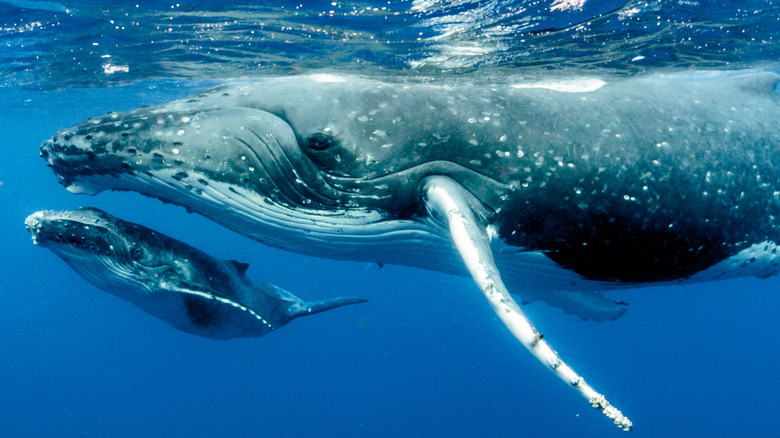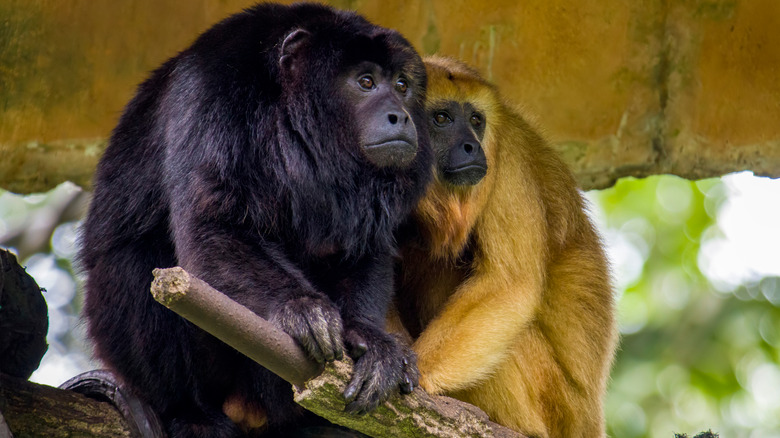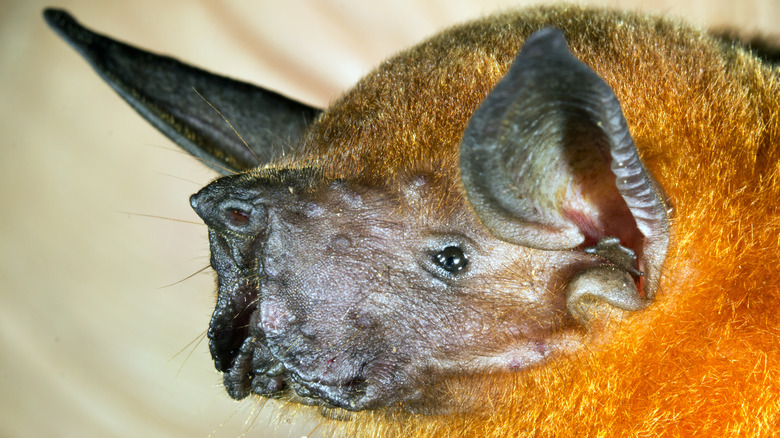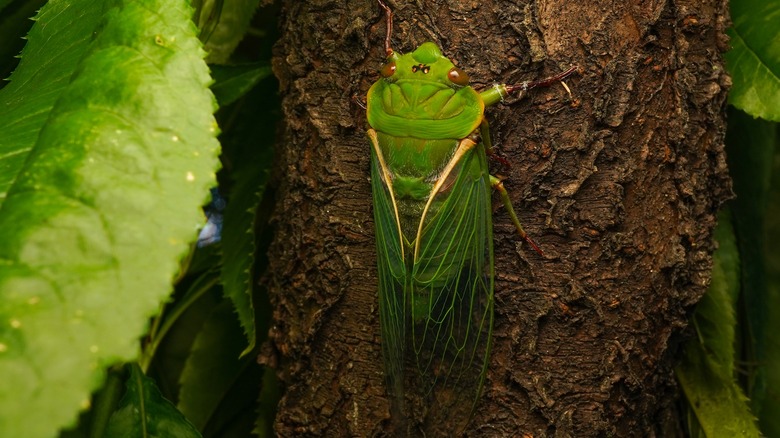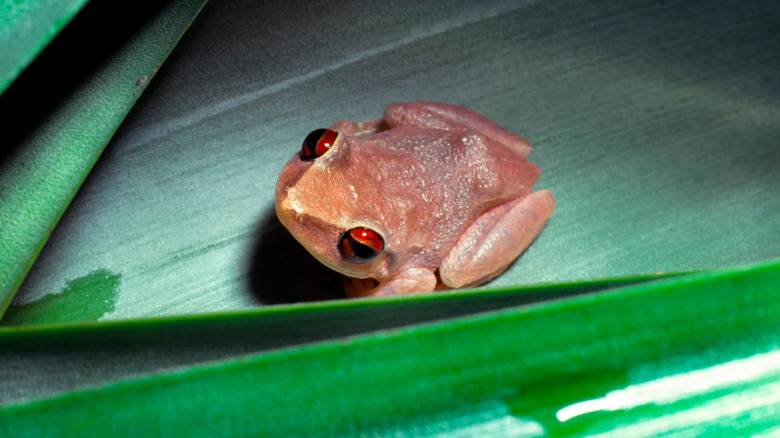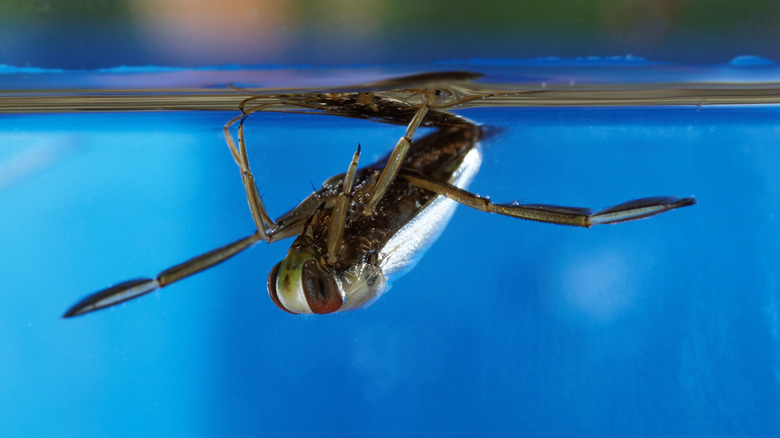Loudest Animals In The World
Anyone who shares a home with a furry or feathery family member knows that things can get pretty loud. Whether it's a dog barking at something in the yard or a cat demanding attention at 4 a.m., it's a simple fact that most animals come with a certain amount of noise. But how do Fido and Fluffy stack up against some of the loudest members of the animal kingdom? Surprisingly? Some of them can throw down with some serious competition.
But let's talk decibels (dB), because, without context, they don't really mean much. The Hearing Health Foundation says that 70 dB is about the level of noise that someone might expect from a standard office, and it's also the threshold between safe and potentially dangerous levels of sound. Prolonged exposure to decibel levels above 70 risks permanent hearing damage and loss, but let's put that in perspective. City traffic (as heard from inside a car or building) clocks in at about 85 dB, while a motorcycle tends to be around 100 dB. A gunshot tops the charts at 140 dB, and it's easy to see how that can eventually do some serious damage to a person's hearing. Where do animals come in on the chart? Surprisingly, they're not just off the chart, but some are way, way off the chart.
Pistol shrimp
Pistol shrimp might be named after a gun (and one particular species, Synalpheus pinkfloydi, is indeed named after one of the biggest bands in music history), but when it comes to actual noise, they're way louder than a gunshot. While the average gunshot comes in at around 140 dB (via the Hearing Health Foundation), these unique crustaceans' sounds have been measured at a whopping 210 dB.
So how, exactly, do they make this sound? It's equally cool and terrifying, and it's enough to make anyone grateful for the fact that they're tiny. According to the Ocean Conservancy, pistol shrimp hunt by opening their massive claws — which can reach a size that's about half their own body length — and drawing water into the joint of the claw. When they close their claws, they create a burst of bubbles that travel so fast that they can kill or stun their prey: When the bubbles pop, that's the sound that gives them the title of one of the loudest animals in the world.
It turns out that in today's rapidly warming world, this could be a problem. Research from the Woods Hole Oceanographic Institution found shrimp get louder and snap more often in warmer waters, and that they're so loud they have the potential to interfere with the communication of other animals — up to and including whales (via USA Today).
Baleen whales
First things first: The Whale and Dolphin Conservatory says that baleen whales are a group of whale species that include the sperm, blue, humpback, and gray whales — and according to BBC Earth, it's whales from this group that are among the loudest creatures in the world... but there's a little more to it. When it comes to sheer volume, there are some clear winners. That starts with the sperm whale: A 1972 study (cited in Scientific Reports) measured the clicking sounds of sperm whales as reaching up to 235 dB. For some perspective, NASA recorded the Saturn V rocket as reaching 204 dB (via Five Thirty Eight). The clicking sounds were thought to be used as a part of their hunting technique, and now, it's believed that it allows them to create a shockingly precise picture of the oceans around them using echolocation.
The blue whale isn't too shabby, either: They've been recorded making sounds up to 180 dB, which is about the same sort of noise a jet engine makes. Interestingly, studies have shown whales aren't just making random sounds, either, and it's the humpback whale who holds some records here. These whales — which sing at between 126 dB and 158 dB, according to the Hawaii Institute of Marine Biology — typically sing in repeating patterns that average around 10 minutes in length. They've also been known to continuously sing for up to 23 hours at a time.
Gulf corvina
Fish generally have a reputation as being pretty quiet pets — neighbors aren't likely to lodge a noise complaint about some goldfish, after all. But shockingly, one of the loudest animals in the world is a fish, and it's called the Gulf corvina.
Research published in Biology Letters looked at the sounds made by these deceptively ordinary-looking (yet at-risk) fish as they gathered for their regular spawning event when individual fish were recorded as making sounds up to 190 dB, 187.2 dB, and 177.3 dB. Researchers further reported (via The University of Texas at Austin) that combined, the sound of the fish reached a shocking 202 dB — which is more than enough to permanently damage the hearing of any person unfortunate enough to be in the immediate area for long.
The sounds come from the fishes' abdomens: When they contract their muscles, those muscles hit air sacs called swim bladders to create sound in a way that biologists compare to a drummer. Timothy K. Rowell of the Scripps Institution of Oceanography was one of the researchers involved, and described the noise to The Washington Post: "When you arrive at the channels of the delta, you can hear it in the air even while the engine is running on the boat."
Marine worms (Leocratides kimurarum)
Worms? Loud? Surely not! It's true, though, and let's talk about some context. According to iac acoustics, sounds that register at 150 dB are loud enough to rupture the human eardrum, and these marine worms are more than capable of doing exactly that.
In 2019, Current Biology published research on a tiny marine worm called Leocratides kimuraorum, which is precisely what a worm should be. It's a completely soft-bodied creature that looks a little hairy and a little transparent. According to Science, they were only discovered in 2017. While they're predictably silent most of the time, it's when they start to fight that things get literally deafening. It's not clear how they're capable of making any noise — completely soft-bodied creatures shouldn't, in theory, be able to — but researchers have recorded what's thought to be both male and female worms making popping sounds that register at a whopping 157 dB.
It's suspected that it has something to do with the way the muscles in their "throats" are configured, but the precise mechanisms remain unknown. Interestingly, the only time they make the sound is when they're fighting: Researchers otherwise disturbed and frightened the worms, but they remained silent. The current theory is that it serves a dual purpose that allows the worm to defend itself and to alert other worms that something terrible is going down.
Black howler monkeys
Black howler monkeys are very aptly named. According to the Los Angeles Zoo, their howls are used to establish dominance and stake out territory for the group. That said, it's not entirely surprising that their voices travel up to three miles. As for loudness, they've been recorded as hitting up to 140 dB, which is up in the neighborhood of a jet leaving the runway.
Not all howler monkeys were created equal, though, and 140 dB is at the top end of the loudness scale. Current Biology reports a hilarious footnote that involves their use of vocalizations to both find a mate and tell rivals that certain ladies are off-limits. Researchers from the University of Cambridge looked at the hyoid bone of individual monkeys, which is the bone in the throat that allows them to make these deafening calls. The larger the bone, the louder the call, which makes sense. They went one step further, though, and compared the size of the hyoid to their sexual endowment — and found that the bigger the throat bone and the louder the call, the smaller the down-below (and the lower the sperm count). In a nutshell (pun intended), the more softly-spoken monkeys tended to live in groups that were equally split between male and female, while the loud monkeys — who actually didn't have much to brag about — tended to attract harems of females. Is there a lesson to be learned here? Maybe.
Bulldog bat
The tiny bulldog bat is one of the loudest bat species ever recorded, and they're so loud that according to researchers from the University of Southern Denmark in Odense and the University of Ulm, Germany (via New Scientist), they — along with other species — have adapted to be able to close their ear muscles at the same time they scream. That only blocks some of the sound of their own voices, though, which means a swarm of bats must sound catastrophic to them.
So... why isn't the night sky filled with the sound of a bat-centric rock concert? Because they're screeching, squealing, and squawking at a frequency that's well out of the range of human ears — and that's a good thing, because researchers recorded the lesser bulldog bat as hitting 137 dB. And that, they think, is a little on the low side because of the difficulties in recording the night-flying creatures.
That's particularly impressive considering the bats only weigh about 50 grams or less than 2 ounces. According to NBC News, there might be a surprising application for these calls: Researchers are using recordings to "teach" artificial intelligence in hopes of creating robots with ultra-effective sonar capabilities.
The white bellbird
The World Wildlife Fund says that the world's loudest bird is the white bellbird of the Amazon, and hilariously, the bird's ridiculously loud call — which reaches up to 125 dB — has nothing to do with long-distance communication, or being heard over the noise of the rainforest. It's only the males that can make the sound — which sounds a bit like a siren — and they do it to attract a mate. From across the rainforest? Nope!
According to a study published in Current Biology, researchers found that the male white bellbird has a few different calls — and the loudest one only kicks off when a desirable mate is in close proximity to him. Sometimes, she's even sitting on the same branch as he is, which is when he starts doing the bird equivalent of blasting an air horn in her face. Researchers write that there are no other species that are both that loud and produce a call so close to their potential mate. And yes, they confirm that males position themselves to squarely face the females, who flinched away from the sound. They speculate that there's some kind of benefit the females get when they can see — and hear — the display at close range because they're risking hearing loss to do it.
The second-loudest bird call also gets an honorable mention here: The aptly-named screaming pihas has been recorded hitting levels of 116 dB.
Green grocer cicada
The Australian Museum says that the Greengrocer cicada is found across the southeastern part of Australia, and they describe their call — which they usually make at dusk and dawn — as "extremely loud and penetrating." That's being incredibly polite.
The greengrocer cicada uses its deafening calls for two reasons, says Australian Geographic. At the same time that it's a mating call used during the relatively short, six-week adult stage of the cicada's life, it also helps keep predators away for the simple fact that it's so stinkin' loud. It's so loud, in fact, that when a group of large cicadas gathers, birds will usually opt to go elsewhere instead of partaking in what would be an absolute feast. And although there are hundreds of different types of cicadas — some of which make no noise at all — the greengrocer has been recorded hitting levels of 120 dB. That, says the Hearing Health Foundation, is on par with the noise levels at a standard rock concert.
Lions
Anyone sharing their home with a cat knows that they can be loud, particularly around dinner. At the end of the day, though, the standard housecat doesn't have anything on a lion — and honestly, not many other animals do.
According to the Smithsonian, the typical lion's roar is measured at around 114 dB. That, says International Noise Awareness Day, is in the general area of a chainsaw, pneumatic drill, or jet plane sitting on the runway. That makes them the loudest of the big cats, and it's a sound that travels, too — as much as five miles (per the BBC). Interestingly, that's just a little bit louder than that piercing cry that babies are so good at, and there's a weird yet fascinating connection between babies and lions.
Post-mortem testing done on Henry Doorly Zoo lions and tigers that had been euthanized due to old age revealed some of the secrets of just how these big cats are able to make such loud noises, and it's thought to have something to do with the shape of their vocal folds. Unlike other cats (and animals), lions have triangular vocal cords that allow for much more air to pass through, which basically means they can make louder noises without having more powerful lungs. And that's where the similarity to human babies comes in: The texture of the vocal folds of a lion was similar to a baby's — "very loose and gel-like" — allowing for some serious vocal projection.
Charlie the Golden Retriever
Saying that "Charlie the Golden Retriever" is one of the loudest animals on the planet isn't a joke: Charlie is a very real Golden Retriever who hails from Australia and holds a place in the Guinness Book of World Records for the loudest dog bark. He set the record in 2012 when his bark was recorded as hitting a whopping 113.1 dB — which puts his bark only slightly softer than a lion's roar. To put that in perspective, there's another bark-related record recognized by Guinness, and that's the loudest group of dogs. In 2009, a group of 76 dogs barking together hit 124 dB — not too far off from Charlie's record-setting bark.
But, where does that put Charlie with respect to other dogs? According to PetKeen, most dogs can easily hit 80 dB, with some — particularly hunting and working breeds — capable of easily hitting 100 dB. It makes sense, after all: Herding dogs need to be able to be heard and understood over a flock of sheep or a herd of cattle, and hunting dogs need to be able to communicate with their handlers over great distances. Before Charlie smashed the record, the award-winner for the loudest dog bark was a UK-based German Shepherd named Daz, with a respectable 108 dB (via the BBC).
Coqui frog
The Coqui frog, says Popular Science, was named for a distinctive — and very loud — call: "ko-kee, ko-kee!" Originally native to Puerto Rico, the frog held an important place in the stories of the native Taino, who told a story that the frog's unique call was made at the behest of a goddess who wanted to make sure the name of her beloved was never forgotten. And the name hasn't been, especially considering that not only can the frogs sing with a song that's up to 90 dB loud, but they've spread across other islands, and into the mainland U.S.
That means they've become a pretty good example of how different sounds mean different things to different people. The frogs are widely beloved in Puerto Rico, where their drone — which is roughly equivalent to standing beside a lawn mower — is a way of life. According to The Washington Post, though, other areas find the noise less desirable. In the 1980s, coqui frogs somehow hitched a ride to Hawaii, where they've continued to thrive to an almost ridiculous degree, with one study finding a 2.5-acre swath on Big Island that contained 91,000 of them... give or take. It was so bad that at one point — in 2005 — a state of emergency was declared: So many people just didn't want to deal with the frogs that it was having a devastating impact on the state's economy.
Water boatman
At first, 99.2 dB might not sound like it's too loud, especially when compared to some other animals. Comparatively, the Centers for Disease Control and Prevention says that it's about the same as a typical sporting event, or the sort of noise someone experiences when they're standing on a subway platform and the train's coming. But here's the thing: The creatures making that noise are less than an inch long, and researchers from the University of Strathclyde say (via The Telegraph) that it makes them the loudest animals in the world... when factoring in their relative body size.
The tiny creatures are called water boatmen, and researchers explain that if a person happened to be walking along a body of water that they lived in, they would be perfectly audible to the human ear — even though 99% of the volume of their call is lost when it crosses the water-to-air boundary.
And what's being transmitted isn't a vocal call at all, it's actually a sound that only males can make when they're advertising for a mate. According to Dr. James Windmill, the exact way they do it is unknown, but what is known is that it involves rubbing the male member against the abdomen — and for some context, they're such tiny creatures that they're talking about an area no wider than a single human hair. Windmill suggests that if they can crack the mystery of just how it's done, it could have endless applications in engineering and acoustics.
